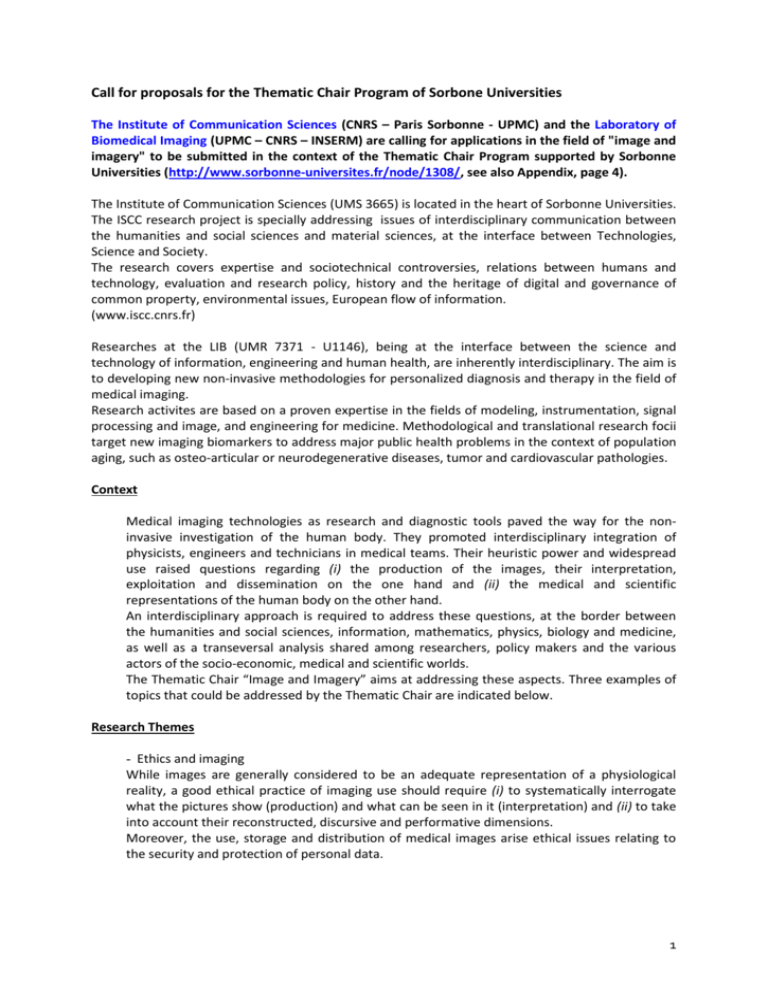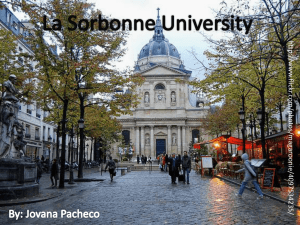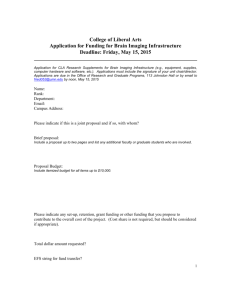Funding
advertisement

Call for proposals for the Thematic Chair Program of Sorbone Universities The Institute of Communication Sciences (CNRS – Paris Sorbonne - UPMC) and the Laboratory of Biomedical Imaging (UPMC – CNRS – INSERM) are calling for applications in the field of "image and imagery" to be submitted in the context of the Thematic Chair Program supported by Sorbonne Universities (http://www.sorbonne-universites.fr/node/1308/, see also Appendix, page 4). The Institute of Communication Sciences (UMS 3665) is located in the heart of Sorbonne Universities. The ISCC research project is specially addressing issues of interdisciplinary communication between the humanities and social sciences and material sciences, at the interface between Technologies, Science and Society. The research covers expertise and sociotechnical controversies, relations between humans and technology, evaluation and research policy, history and the heritage of digital and governance of common property, environmental issues, European flow of information. (www.iscc.cnrs.fr) Researches at the LIB (UMR 7371 - U1146), being at the interface between the science and technology of information, engineering and human health, are inherently interdisciplinary. The aim is to developing new non-invasive methodologies for personalized diagnosis and therapy in the field of medical imaging. Research activites are based on a proven expertise in the fields of modeling, instrumentation, signal processing and image, and engineering for medicine. Methodological and translational research focii target new imaging biomarkers to address major public health problems in the context of population aging, such as osteo-articular or neurodegenerative diseases, tumor and cardiovascular pathologies. Context Medical imaging technologies as research and diagnostic tools paved the way for the noninvasive investigation of the human body. They promoted interdisciplinary integration of physicists, engineers and technicians in medical teams. Their heuristic power and widespread use raised questions regarding (i) the production of the images, their interpretation, exploitation and dissemination on the one hand and (ii) the medical and scientific representations of the human body on the other hand. An interdisciplinary approach is required to address these questions, at the border between the humanities and social sciences, information, mathematics, physics, biology and medicine, as well as a transeversal analysis shared among researchers, policy makers and the various actors of the socio-economic, medical and scientific worlds. The Thematic Chair “Image and Imagery” aims at addressing these aspects. Three examples of topics that could be addressed by the Thematic Chair are indicated below. Research Themes - Ethics and imaging While images are generally considered to be an adequate representation of a physiological reality, a good ethical practice of imaging use should require (i) to systematically interrogate what the pictures show (production) and what can be seen in it (interpretation) and (ii) to take into account their reconstructed, discursive and performative dimensions. Moreover, the use, storage and distribution of medical images arise ethical issues relating to the security and protection of personal data. 1 - Imaging and representation of the human body Medical imaging tends to produce a new representation of a transparent body, which has become permeable to the investigation. The ontology of medicine is also modified and interpretative structures, that remained unthinkable until recently, appear within reach of the human knowledge (e.g., brain areas). Imaging generates a "reality effect" which makes one see the pathologies and produces a new speech (on psychological disorders, typically). These are reflected throughout the communicative chain, from radiologists to media. - Imaging , innovation, society Medical imaging provides a ground for innovation through the cross-fertilization of knowledge between users and producers of the images. This field must be analyzed to understand the successes and stress points. If technological innovation has been responsible for the expansion of medical imaging since the early twentieth century, it can no longer develop outside of an integrated approach between research, industry, politics and society. Interdisciplinarity should thus be extended to the humanities and social sciences to continue and strengthen this movement and, ultimately, to improve the management, information and treatment of patients. Operational environment The ISCC provides an interdisciplinary scientific environment with proximity of six thematic clusters it hosts: Environmental governance and socio-technical controversies Risks, innovation, expertise Digital trajectories Governance of commons Frontiers of the Human Dynamics of research, organization, communication and evaluation The LIB provides a scientific environment that ensures : the expertise of the entire chain of knowledge production by and for imaging, including modeling, instrumentation, signal and image processing, animal expriments and access to cohorts of patients, access to corresponding resources and data easy access to local facilities and imaging platforms (Ultrasound, MRI, CT and SPECT, PET) a permanent multidisciplinary team of researchers and technicians, including physicists, engineers, mathematicians, computer scientists, biologists, clinicians close collaborations with biologists and clinicians for translational research from animals to humans numerous national and international collaborations and a strong commitment to technology and clinical transfer. The ISCC and the LIB will provide dedicated offices and meeting rooms for the program coordination (ISCC is located at 20 rue du Berbier du Mets, Paris 13; LIB is at the Centre de Recherches des Cordeliers, Paris 06 and School of Medicine Pierre et Marie Curie, Paris 13). They also guarantee the access to common resources (computers and network, library resources, support for publication and communication) during the program. The ISCC will manage the program and ensure monitoring of all administrative related tasks. 2 Funding Applicants are invited to submit projects that justify support from Sorbonne Universities amounting between € 500k and € 1 million, for a period of 12 to 24 months. A detailed financing plan shall be provided, individualising funding requested from the Sorbonne Universities and the contributions from other participating institutions. The accompanying funding from Sorbonne Universities includes: The salary of the Senior Chair The salary of junior Chair Salaries of PhD students and / or postdocs Overheads Candidates will provide: a curriculum vitae, list of publications, conferences and communications, and the list of recent contracts; a letter of motivation; name of three to five scientists that can write a letter of reference a research and educational program for a minimum period of 12 months (24-month programs are recommended). The candidate for Senior Chair shall not have worked full time in a team partner of the project for at least 5 years The successful candidate will have the following qualifications: An international reputation and visibility in the field of biomedical imaging. Proven skills to work in an interdisciplinary environment (biology, information sciences, humanities and social sciences). Good communications skills; Good management skills; Contacts : - ISCC : Pascal GRISET, pascalgriset@icloud.com LIB : Pascal LAUGIER, pascal.laugier@upmc.fr Applications must be received before April 30, 2014 chaire-LIB-ISCC@cnrs.fr 3 Appendix: Thematic Chairs program of Sorbonne Universities The objective of the “Thematic Chairs” program of Sorbonne Universities is to foster, by the recruitment of high-level researchers, the implementation of interdisciplinary teaching and research programs addressing the priority scientific strategy of Sorbonne universities. The “Thematic Chairs” program has the ambition to strengthen interdisciplinarity through the development of new fields of research and teaching, characterized by their inclusion in complex problems, built around questions and challenges of scientific and societal interest. Expected results The ““Thematic Chairs” program is a commitment from Sorbonne Universities to achieve new strategic goals based on interdisciplinarity and to become a first class international institution for the production of knowledge in areas of innovative research associated with innovative training. The program offers the opportunity to change the scientific approach and the practice in both teaching and research by a permeabilization of academic disciplinary boundaries and by integration of concepts provided by the different disciplines. The program should lead to the definition of new profiles of researchers based on criteria of interdisciplinarity and ability to hold the leadership in emerging resarch and training programs. It will allow Sorbonne Universities to acquire new skills and knowledges, and ultimately, to provide new answers to today's and tomorrow’s major socio-economic issues. By attracting prominent scientists to support the development and consolidation of new interdisciplinary fields of research and training, the program should contribute to increasing the attractiveness and reputation of Sorbonne Universities within the international scientific community. Caracteristics of the program An interdisciplinary research program supported by the least two institutions of Sorbonne Universities, selected among the thematic areas identified by Sorbonne Universities. A scientific environment including a group of teams from different disciplines involved in defining and supporting the research program. This group will be coordinated by a permanent researcher employed by one of the institutions of Sorbonne Universities. The scientific referent is responsible for the coordination and animation of interfaces between teams and the Senior Chair. An operating environment defined by a provision of dedicated premises by the partner institutions of the program and access to shared resources (equipment, platforms, etc ...) A Senior Chair1 who will be recruited on contract, or on a tenure position, and hosted by a member of Sorbonne Universities, on a job profile in line with the strategic and interdisciplinary objectives of the proposal. An interdisciplinary research program, accompanied by an educational project for a minimum period of 12 months (24 months is recommended). 1 Senior Scientist: having defended his thesis since ten years at least and with a an already strong established scientific reputation recognized at the highest international level 4 Coordinated recruitment (junior chair2, postdocs and PhD students) can be achieved by other institutions partners of the project. Funding by Sorbonne Universities for all recruitment of personnel, for equipment and operation of the Chair, for a minimum period of 12 months. Documents to be provided by the candidate Curriculum vitae, list of publications, conferences and communications, list of recent contracts, letter of motivation. Research program and teaching program for a minimum period of 12 months (24-month programs are recommended). Recruitments necessary for the implementation of the project Funding: Applicants are invited to submit projects that justify support from Sorbonne Universities amounting between € 500k and € 1 million, for a period of 12 to 24 months. A detailed financing plan shall be provided, individualising funding requested from the Sorbonne Universities and the contributions from other participating institutions. The accompanying funding from Sorbonne Universities includes: The salary of the Senior Chair The salary of junior Chair Salaries of PhD students and / or postdocs Overheads 2 A PhD having at least 3-year post-doctoral experience 5









